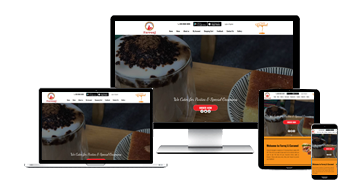Table of Contents
Implementing restaurant targeted advertising enables more effective connection with potential customers who are likely to patronize their establishment.
Getting your messaging in front of the right people is critical in the highly competitive restaurant industry. Targeted advertising for restaurants allows to optimize their online advertising budget by focusing spending on audience segmentation and demographic targeting.
This results in higher engagement from ideal customers and supports a data-driven approach to marketing. This article will examine how restaurants can leverage different forms of targeted advertising and deploy customer engagement strategies powered by data analytics.
We will also explore emerging trends and technologies that are shaping the future of precision advertising.
The foundation of executing targeted campaigns is taking the time to analyze and understand your target customers for restaurants. There are several key categories of information to study:
Understanding Your Target Audience
Creating different groups of customers based on things like their interests and what they buy, also known as audience segmentation, is a big deal in advertising. It lets your ads connect with people on a personal level. When you actually get who your target audience for restaurants and what matters to them, your ads will feel way more relevant.
Demographic Analysis
Important demographic factors include:
- Age – targeting different generations like Baby Boomers, Millennials etc.
- Gender
- Income level – budget-conscious students vs affluent professionals
Psychographic Analysis
Look at lifestyle choices and interests like:
- Dining preferences – fast casual vs fine dining
- Cuisine inclinations – Italian, Indian, seafood etc.
- Hobbies – sports fans, health enthusiasts etc.
Behavioral Analysis
Study real-world patterns such as:
- Frequency of dining out
- Average transaction value
- Online engagement on social media platforms


Platforms of Targeted Advertising for restaurants
There are several key channels restaurants rely on:
Influencer Collaborations
Partner strategically with credible voices like prominent regional chefs to expand awareness. Ensure values and voice align authentically.
Carefully developing integrated plans across key digital venues enables more targeted, effective restaurant advertising strategies for elevating your restaurant’s brand presence online.
Social Media Marketing
Platforms like Facebook ads and Google ads provide extensive audience profiling capabilities. You can target consumers based on:
- Demographic factors like age, gender, income level
- Behavioral signals – purchase history, pages liked etc.
- Context – ads in relevant newsfeeds and posts
This allows for superior personalization and alignment with their dining preferences.
Search Engine Advertising
Search platforms like Google allow advertisers to have their ads appear alongside relevant search queries. For example, ads can be displayed when users search for terms like:
“[restaurant name] menu”
“new restaurant in [city]”
“[cuisine type] near me”
The relevance here leads to higher click-through rates.
Email Marketing
Building an email subscriber list allows you to group together users based on attributes like:
- Location
- Favorite cuisine
- Special occasions like birthdays
You can then craft targeted email campaigns and personalized promotions.
Strategies for Targeted Advertising messages
An effective marketing strategy starts with selecting the right platforms to reach your restaurant target markets. To implement targeted advertising effectively, restaurants can:
Utilize Data Analytics
Using customer relationship management (CRM) systems and cleaned point-of-sale data allows you to identify:
- Your VIP customers who drive most revenue
- Slow periods like Tuesday afternoons
- Menu items having higher popularity
These data-driven insights inform your targeting strategy.
Creating Compelling Content
Your ads must feature:
- Engaging visuals – vibrant images of food
- Persuasive copywriting – conveys value clearly
This content must be tailored to resonate with each target customer group.
Implement Geotargeting
You can target advertising to users within a certain geographic radius from your restaurant location. Tactics like geo-fencing ads allow you to deliver ads to devices entering that region. This facilitates location-based promotions.
Case Studies
Let’s analyze examples of effective targeted advertising from major restaurant chains:
McDonald’s #MyMcDonald’s Campaign
The global fast food giant launched a personalized campaign focused on customization and relevance to the individual. By integrating their app database with customer insights, they delivered tailored mobile offers on customized burgers, drinks and more. It was a runaway success and became their most downloaded app promotion.
Key Takeaways: personalization and mobile app integration
Starbucks Birthday Campaign
For several years, Starbucks has run local email campaigns encouraging loyalty members to pick up a complimentary birthday treat during their birthday month. This exclusive offer and recognition helps drive increased visits and spend beyond the free item.
Key Takeaways: loyalty programs and occasion-based promotion
Challenges and Solutions
There are some common pitfalls to address:
Privacy Concerns
Customers have grown sensitive to how brands use their data. Maintaining transparency and allowing them to opt-out helps sustain trust.
Adapting to Shifts
As consumer behavior evolves, your messaging must keep pace across channels like mobile apps. Continually test for the most effective content types.
Measurement Difficulties
Isolate key performance indicators and track them diligently to optimize your ad strategy over time. Common metrics include cost per click, conversions and customer lifetime value.
Future Trends
Exciting innovations on the horizon will allow restaurants to take targeted marketing to new levels through:
AI and Machine Learning Integration
Artificial intelligence and machine learning allow for deeper customer profiling based on factors like past ordering data and engagement patterns. As algorithms become more advanced, they will enable ultra-personalized real-time promotions.
Marketing Automation
Restaurants can leverage data-based triggers to automate campaigns across channels. For example, email and social ads promoting seasonal menu items could deploy automatically based on purchase history.
Expanded Online Ordering Targeting
With the rising popularity of restaurant business online ordering, expanded targeting dimensions become available such as order size, frequency, and past item preferences. Campaigns will dynamically adjust to match customer behavior.
As technology unlocks more robust targeting capabilities, restaurants can elevate relevance and drive higher engagement. Combining innovation with creativity will be key to breakthrough brand awareness.
Exciting technologies on the horizon include:
- Virtual reality ads like interactive restaurant menus
- Artificial intelligence to deliver individualized promotions
- Machine learning algorithms that learn from customer behavior
These innovations will enable greater depths of personalization and help make budget feel limitless.
Conclusion
Targeted advertising is essential for restaurants navigating rising digital marketing costs and information overload faced by consumers. By taking the time to understand your unique audience segments and tailoring your messaging for relevance, you can break through the noise. This discipline also applies to experimentation with emerging formats and platforms. The future of advertising for restaurants is ultra-personal and hyper-targeted. Now is the time to adopt these practices into your strategy if you haven’t already.
Targeted and relevant advertising is a powerful way for restaurant online ordering takeaway to connect with their best potential users, drive more transactions, increase adoption, and continually improve advertising performance.
Reference:










